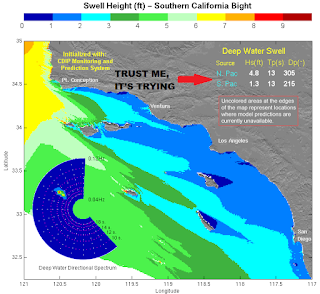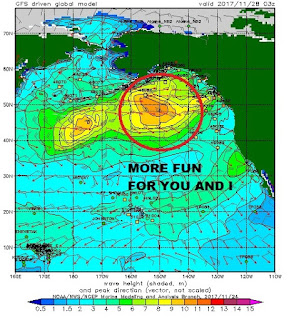Not taking it for granted.
SURF:
I’m definitely grateful for the lack of wind we’ve had lately and the fun surf. I know we need the rain but I’ll take clean conditions any day.
FORECAST:
The Aleutians are still active and we have more NW headed our way.
WEATHER:
Lots of awesome sunsets and no rain in sight. As mentioned above, we have nice weather this weekend then a weak cold front moves by to the N on Monday. We’ll just see more clouds and breezy conditions- but no showers. After that, high pressure is forcasted to set up and we could have a moderate to strong Santa Ana offshore wind event. With the lack of rain, I hope not. Don’t need any fires around here. If anything changes between now and then, make sure to keep up to date on the waves and weather at Twitter/North County Surf.
BEST BET:
Saturday with nice conditions again and fun NW or next weekend with NW/SW combo and offshore winds potentially.
NEWS OF THE WEEK:
As you know, La Nina conditions set up in the equatorial Pacific this summer and it effectively shut down our hurricane surf for the West Coast. What does that mean on the opposite side of the US? The opposite of course- one heck of a hurricane season. Here’s the official report from the National Oceanic and Atmospheric Administration:
Today marks the official end of the 2017 Atlantic hurricane season, which matched NOAA’s seasonal predictions for being extremely active. The season produced 17 named storms of which 10 became hurricanes including six major hurricanes (Category 3, 4 or 5) – including the first two major hurricanes to hit the continental U.S. in 12 years.
Based on the Accumulated Cyclone Energy index, which measures the combined intensity and duration of the storms during the season and is used to classify the strength of the entire hurricane season, 2017 was the seventh most active season in the historical record dating to 1851 and was the most active season since 2005.
This year, three devastating major hurricanes made landfall (Harvey in Texas; Irma in the Caribbean and southeastern U.S.; and Maria in the Caribbean and Puerto Rico). Harvey was also the first major hurricane to hit the U.S. since Wilma struck Florida in October 2005. Additionally, four other storms hit the U.S., including Cindy in Texas, Emily and Phillipe in Florida, and Nate in Mississippi.
“This was a hurricane season that wouldn’t quit,” said retired Navy Rear Adm. Timothy Gallaudet, Ph.D., acting NOAA administrator. “The season started early with a storm in April and the peak of the season featured an onslaught of ten successive hurricanes. NOAA forecasters rose to this challenge to keep emergency officials and the public aware of anticipated hazards.”
“In six short months, the next hurricane season will be upon us,” added Gallaudet. “This is a good time to review and strengthen your preparedness plans at home as we continue to build a Weather-Ready Nation.”
The 2018 Atlantic hurricane season officially begins on June 1 and NOAA’s Climate Prediction Center will provide its initial seasonal outlook in May.
PIC OF THE WEEK:
What a reef break should look like.
Keep Surfing,
Michael W. Glenn
Mind-boggling
Harry’s Best Man
Shaping Organic Surfboards; Surf On It, Then Eat It

















































